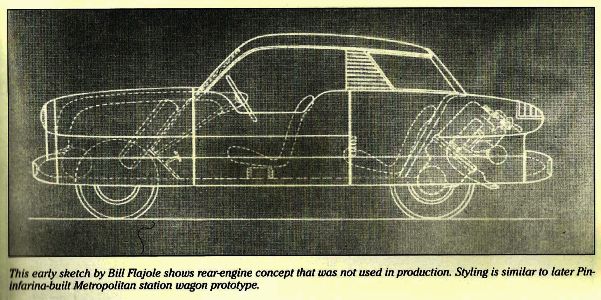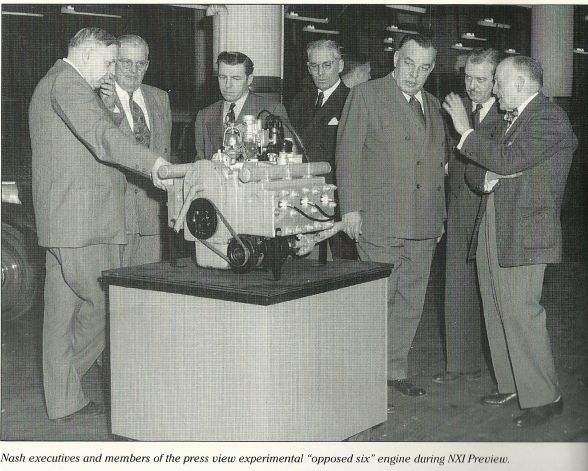Thursday, September 23, 2021
Y no amortize?
In a recurring pattern, all carmakers propose a radical small car, then either abandon it or normalize it. In the fast-inventing '30s, both Ford and Chrysler considered rear-engine small cars. The Chrysler idea included a 5-cylinder radial air-cooled aircraft engine, which is about as radical as you can get. Ford's rear-engine idea turned into the Zephyr, with conventional engineering and a beautifully streamlined body. The Zephyr mainstreamed streamlining. Later, both Ford and Kaiser considered FWD cars and abandoned them.
Nash atypically fell into the same pattern in '49 when it was trying out ideas for the tiny Metropolitan.
 This idea would have used a water-cooled boxer six, oddly tilted. The angle would have introduced a slew of unnecessary problems, and you can see from the diagram that the tilt wasn't needed anyway. The engine would have fitted horizontally without stretching the body.
Though the configuration was dumb, the engine itself was well developed and compact:
This idea would have used a water-cooled boxer six, oddly tilted. The angle would have introduced a slew of unnecessary problems, and you can see from the diagram that the tilt wasn't needed anyway. The engine would have fitted horizontally without stretching the body.
Though the configuration was dumb, the engine itself was well developed and compact:
 It appears to have the typical Nash manifold-less exhaust. Interesting expressions on the unidentified men. Puzzled but trying to act confident. All of them are 'looking askance' at the engine.
Why atypical? George Mason had a nearly perfect sense of direction. He deeply understood the Booker T rule. Stick to your niche, maintain your niche, develop your skills to the max, amortize to the max, don't waste energy on speculation.
Thus it's surprising that Nash didn't try to reuse and amortize this engine. It was too powerful for the Metro, and wasn't needed in the standardized Ramblers.
Where would it belong perfectly? PACER.
It appears to have the typical Nash manifold-less exhaust. Interesting expressions on the unidentified men. Puzzled but trying to act confident. All of them are 'looking askance' at the engine.
Why atypical? George Mason had a nearly perfect sense of direction. He deeply understood the Booker T rule. Stick to your niche, maintain your niche, develop your skills to the max, amortize to the max, don't waste energy on speculation.
Thus it's surprising that Nash didn't try to reuse and amortize this engine. It was too powerful for the Metro, and wasn't needed in the standardized Ramblers.
Where would it belong perfectly? PACER.
 This idea would have used a water-cooled boxer six, oddly tilted. The angle would have introduced a slew of unnecessary problems, and you can see from the diagram that the tilt wasn't needed anyway. The engine would have fitted horizontally without stretching the body.
Though the configuration was dumb, the engine itself was well developed and compact:
This idea would have used a water-cooled boxer six, oddly tilted. The angle would have introduced a slew of unnecessary problems, and you can see from the diagram that the tilt wasn't needed anyway. The engine would have fitted horizontally without stretching the body.
Though the configuration was dumb, the engine itself was well developed and compact:
 It appears to have the typical Nash manifold-less exhaust. Interesting expressions on the unidentified men. Puzzled but trying to act confident. All of them are 'looking askance' at the engine.
Why atypical? George Mason had a nearly perfect sense of direction. He deeply understood the Booker T rule. Stick to your niche, maintain your niche, develop your skills to the max, amortize to the max, don't waste energy on speculation.
Thus it's surprising that Nash didn't try to reuse and amortize this engine. It was too powerful for the Metro, and wasn't needed in the standardized Ramblers.
Where would it belong perfectly? PACER.
It appears to have the typical Nash manifold-less exhaust. Interesting expressions on the unidentified men. Puzzled but trying to act confident. All of them are 'looking askance' at the engine.
Why atypical? George Mason had a nearly perfect sense of direction. He deeply understood the Booker T rule. Stick to your niche, maintain your niche, develop your skills to the max, amortize to the max, don't waste energy on speculation.
Thus it's surprising that Nash didn't try to reuse and amortize this engine. It was too powerful for the Metro, and wasn't needed in the standardized Ramblers.
Where would it belong perfectly? PACER.
Labels: Alternate universe
